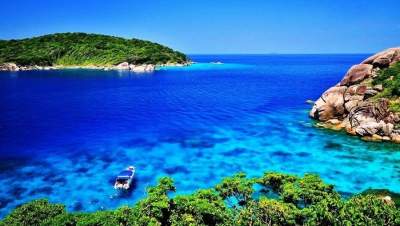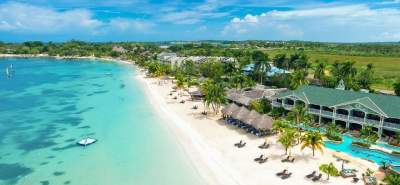 Tourists flooded the place.
Tourists flooded the place.
The authorities of the countries where these attractions take the measures that the crowds of tourists haven’t destroyed them.
In Thailand the beach, Maya Bay closed to tourists.
But that’s not all – a number of European cities, including Venice and Dubrovnik and also the Isle of Skye in Scotland have complained that barely survive in the invasion of tourists.
Bi-bi-si has presented a list of five popular tourist destinations, the welfare of which is threatened due to the increasing number of visitors.
Thailand: beach Maya Bay take a break from the tourists. In March, the government of Thailand has announced that it closed four months the famous beach of “prevention”. Currently every day the beach is visited by 4-5 thousand tourists.
77% of the coral reefs in this Bay are under threat of destruction, mainly corals are damaged by anchors of boats plying here.
Elizabeth Becker, author of a book about the problems of the tourism industry said: “the Decision to close the island’s well-founded. But tourism is one of the driving forces of economic development of the country. And business, and officials fear that any restriction in tourism will endanger the whole economy of the country.”
According to the expert from Bangkok Thana of Thamrongnawasawat, for this reason, the authorities decided to close the beach of Maya Bay. “If you live in the country, 22% of GDP, which is income from tourism, you will understand how difficult such decisions. Many people never thought that such a decision can ever be taken”, – said the expert.
The beach Maya Bay opens again, the Thai authorities will impose a limit: it will be available for no more than 2 thousand tourists a day.
But Italy and pearl of the Cinque Terre hopes on technology. Tourists will always be a little of the Cinque Terre – five small, colorful villages on man-made terraces on the coast of the Gulf of Genoa. This area that is home to 5 thousand, it became a national Park in 1999. Now Cinque Terre is visited by over 2 million tourists a year.
Tourists come here to stroll along the scenic trails that link together the five settlements located on the terraces of the vineyards. But over the years these trails have become unusable – due to erosion and crowds of tourists.
The management of the Park some time ago tested a mobile application for tourists, which in real time displays the number of people on certain routes. When the app shows a red warning signal, this means that on the trail too many people, then tourists can decide whether to go via the congested route.
In the future, as hopes the management of the Park, with the app you can create a waiting list after exceeding the permitted number of people on the trails.
Machu Picchu – located in Peru, the ancient Inca city is firmly occupied one of the main places in the program travel of many tourists. However, the large flow of tourists has a negative impact on the environment: the trail gradually becomes unfit for use, along the heaps of garbage and the tourists put up tents where it is not allowed.
In 2005, Peruvian authorities have imposed restrictions on the number of people that can climb the trail to Machu Picchu for the season. In February the route is regularly closed “prevention”.
Tourists must now pre-book a permit to climb to the city on the Inca trail.
However, due to the fact that Machu Picchu can be lifted and on the road, the number of visitors to the ancient city due to the introduction of these restrictions has not decreased. That is a road used by the majority of visitors to Machu Picchu.
Yet, despite all the efforts of the authorities to control the flow of tourists, the number of visitors to Machu Picchu exceeds the recommended UNESCO 2500 people a day.
South Korea: Jeju island – tourists come here to view the volcanoes, picturesque waterfalls, and also to visit the “Park of love”, which is particularly popular with honeymooners who are planning their honeymoon travel.
In 2017, between the island and Seoul were committed 65 thousand flights – that is, nearly 180 flights per day. Every year about 15 million tourists come to the island, but this is too much for the island area of 2 thousand sq m.
“After the island became popular with foreign tourists, the environment, the island was severely damaged. Now there’s a lot of garbage and the congested roads,” – said the head of the local activist groups Kang-Won-bo.
“The island also comes a lot of tourists on cruise ships, tourists are here only a few hours and not actually bring any income to the local economy,” says tourism consultant in Seoul Kathryn Germie-Hamill.
Colombian caño Cristales – a fantastic spectacle is the river, which shimmers all the colors of the rainbow.
The territory through which the river, had been under the control of the FARC rebels, this means that tourists – both local and foreign – there is not actually there. But in recent years – after the Colombian government in 2016, has signed an agreement with the FARC – here began arriving travelers to see with their own eyes this miracle of nature.
Of course, the caño Cristales can not boast the same number of visitors as other attractions list (in 2016 to see the river came 16 thousand tourists), but it is very difficult to find a balance between the growing number of tourists and the preservation of the extremely fragile ecosystem.
There are fears that further rostila of tourists can cause pollution and loss of unique water plants.
“The presence of people can harm the reproductive process of plants. We therefore decided to introduce certain restrictions,” – says program coordinator on ecotourism Faber Ramos.








